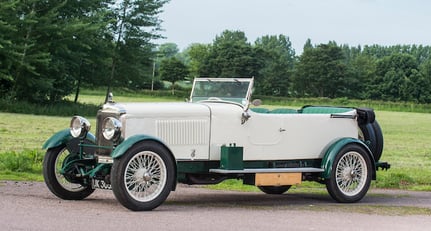1926 Sunbeam 3.0 Liter
-
Baujahr1926
-
Chassisnummer4001G
-
Losnummer294
-
LenkungLenkung links
-
ZustandGebraucht
-
Zahl der Sitze2
-
Standort

-
AußenfarbeSonstige
-
Antrieb2wd
-
KraftstoffPetrol
Beschreibung
First owned by Sir Henry Segrave; the ex-Olympia and Scottish Motor Shows
1926 Sunbeam 3.0-Litre Super Sports Twin-Cam Tourer
Registration no. UK 3059
Chassis no. 4001G
Founded by John Marston, a God-fearing Victorian industrialist who foresaw the growth in demand for private transport, Sunbeam was first associated with beautifully made, though expensive, bicycles. Although comparative latecomers to motor car manufacture, the Wolverhampton-based Sunbeam factory quickly established a fine reputation alongside Lanchester, Wolseley, Austin and Daimler at the heart of the expanding Midlands motor industry.
The company's first conventional car was largely conceived by T C Pullinger, who persuaded Marston to purchase a complete chassis from the French Berliet concern. Exhibited at the Crystal Palace in November 1902, it was marketed as the Sunbeam 10/12, but it was not until 1907, two years after the Sunbeam Motor Car Company had been formed, that the firm produced its first all-British model, the 16/20. The arrival from Hillman in 1909 of influential designer Louis Coatalen and the pursuit of an effective competitions programme enabled the marque to establish a formidable reputation prior to WWI, its superbly made products enjoying a reputation rivalling that of the best from Alvis and Bentley thereafter.
Coatalen's Sunbeams won countless races at Brooklands and set a number of speed records prior to WWI, and after The Great War the firm continued to be active in motor sport at the highest level, supplying racing cars to Henry Segrave (later Sir Henry Segrave). An ex-Royal Flying Corps pilot, Segrave made history in 1923 when he won the French Grand Prix at the wheel of a Sunbeam, thus becoming the first British driver to win a Grand Prix driving a British car. Segrave's car was powered by a new state-of-the art, twin-overhead camshaft, 3.0-litre racing engine designed by Vincent Bertarione, who had been recruited by Coatalen from FIAT.
The Segrave/Sunbeam combination won two further Grands Prix in 1924, and in 1925 he was included in Sunbeam's team contesting the Le Mans 24-Hour race. Two of the new 3.0-litre twin-cam Super Sports road models were entered, and although that of Segrave/Duller retired with clutch trouble after 32 laps, the other, driven by Jean Chassagne and Sammy Davis, finished a magnificent 2nd, beaten only by the Lorraine-Dietrich of de Courcelles/Rossignol.
Drawing on Sunbeam's considerable experience of building double-overhead-camshaft engines for Grand Prix racing, which stretched back to 1914, the 3.0-Litre Super Sports production model was powered by a twin-cam 'six' featuring an eight-bearing crankshaft, twin Claudel carburettors and dry sump lubrication. The chassis specification included a four-speed in-unit gearbox, torque tube back axle, semi-elliptic front suspension, cantilever rear suspension and four-wheel brakes. Producing anywhere between 90 and 120bhp, the Super Sports was capable of 90mph, making it one of the fastest production sports cars of its day.
This 3-Litre Super Sports was first owned by Sir Henry Segrave. As well as an accomplished racing driver, Segrave was an early pioneer in speed record attempts both on land and on the water, setting three land records and one water record. He was the first person to hold both titles simultaneously and the first person to travel at over 200mph on land. Segrave died in an accident in 1930 shortly after setting a new Water Speed Record on Lake Windermere. The 'Segrave Trophy' was established to commemorate his achievements.
The car offered here, chassis number '4001G', was taken to the USA in 1927 together with Segrave's 1000hp Sunbeam Land Speed Record breaker, having been displayed on the Sunbeam stand at the Olympia and Scottish Motor Shows the previous year (see photographs and Motor cartoon on file). The 3-Litre was used to reconnoitre the Daytona Beach course and received much favourable comment from Segrave's American hosts, who were mightily impressed by its 90mph top speed. As for 'Mystery', the twin-engined Sunbeam record breaker, its 1000hp proved sufficient to take back the land speed record from J G Parry-Thomas, setting a new mark of over 200mph for the first time. Further details of Segrave's fascinating American adventure with the two Sunbeams are recounted in copy magazine articles and book extracts on file.
Rather than bring the 3-Litre back to the UK, Segrave sold the car to the American Garfield 'Gar' Wood, holder of the World Water Speed Record. The deal involved the part exchange of two speedboat hulls, as Segrave wanted to make his own attempt on the World Water Speed Record. In October 1938, Wood gave the Sunbeam as a 'Christmas present' to Mr S O Greening of the Greening Wire Company, Ontario, Canada (see letter on file).
Over the next 30 or so years, the Sunbeam had several owners and was extensively modified, including having a Ford V8 'flat head' engine installed. By 1967 it was in a sorry state, having been left outside for ten years. It was then that it was purchased by John Sebert of Toronto to provide spares for another 3-Litre Twin-Cam Sunbeam he owned (chassis number '4062F'), which had been damaged in an accident. The Segrave car's aluminium body was transferred to the damaged car.
In 1978, '4001G' was imported into the UK by one A C Miller, who sold it to a G Harper in 1979. By 1998, the 3-Litre had passed through the hands of three more owners (details available) and was purchased that year by the current vendor, who proceeded to have it professionally restored to its original 1926 specification. After some initial work a full restoration was carried out by Colin Clifford between 2001 and 2004, this challenging task involved manufacturing a replica body in aluminium, and building an engine around a new cylinder block. The car was returned to its specification as seen at the Olympia and Scottish Motor Shows, where it appeared finished in Ivory White with green chassis, mudguards, axles, etc. The running boards and instrument dials were white, and the interior upholstered in green leather, while the Réné Thomas sprung steering wheel (1" larger in diameter than standard) is believed to be an in-period modification made prior to the Daytona trip.
Various modifications and upgrades have been incorporated to make the Sunbeam safer and more reliable. These include coil ignition (using the magneto points); a voltage regulator, wiring, and fuses; electric fuel pump (supply pipe via Autovac); fuel filter; lights adapted to accept modern bulbs; sidelights modified to act as flashing indicators; toolboxes on the running boards; additional windscreen wiper; electric radiator fan; modern oil filter; knock-on wheel nuts (originals retained); heavy-duty brake drums (originals retained); and much more besides. A full list of all modifications is available together with a history file containing photographs of the restoration, copies of related invoices (totalling circa £110,000), and a schedule of the suppliers and firms involved. The file also contains general correspondence, shipping paperwork from 1938, an original handbook, and Sunbeam Talbot Darracq Register letter confirming that chassis '4001G' was registered in January 1927 as 'UK 3059'. The original dials for the cars gauges and instruments have been retained and are offered mounted in a display frame with the lot.
Since restoration, the car has been used sparingly, covering fewer than 9,000 miles. All MoT certificates are present to support this. 'UK 3059' has attended various VSCC events including 'The Great Gathering' of 3-Litre Sunbeams, and has been used as a course car at Cadwell Park. It also attended the STD Register's 80th anniversary at Beaulieu of the 1927 Land Speed Record; has won several 1st Class concours d'élégance awards; and been filmed for the BBC's 'Antiques Roadshow' Sports Relief Special with presenter Tim Wonnacott at Lord's Cricket Ground. A full write up of the car has been published in Practical Classics magazine, and it has also been featured in Classic & Sports Car and The Automobile.
One of only 305 manufactured between 1925 and 1930, this superb Sunbeam Twin-Cam represents the very pinnacle of engineering excellence in the Vintage era. A wonderful opportunity to acquire a fine example of this most prestigious British marque, it exudes period charm and is eminently suitable for a variety of VSCC and other historic events - the perfect addition to any motor house.


























